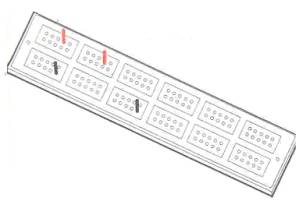CRIBBAGE
CRIBBAGE is believed to have been developed out of the older card game of Noddy, by Sir John Suckling in the reign of Charles I. In the manner of scoring it is unique, and the play calls for no effort of memory. Good judgment and concentration are the chief qualities that lead to success.
NUMBER OF PLAYERS
Originally cribbage was a two-handed game s described first, but variations for three and four players are now played and are described later.
The two-handed game is the most popular, and of it there are three variations: five, six, and seven card.
CARDS
The full pack of 52 cards is used, and they rank from King (high) to Ace (low). The king Queen and Jack! Count as ten each, and the other cards their pip values.
Five-card Cribbage for two players, which is the original game, is generally considered the most scientific of the variations.
The players cut for deal; the lower deals first. Five cards are dealt to each poker player, and the non-dealer pegs three holes (Three for Last) as compensations against the advantage of the first deal of a game.

A cribbage or noddy board.
THE PLAY
Points won are marked with a peg on what is known as a noddy board (see illustration). It is oblong in shape, has a double row of holes, 30 in each row, and is divided, for convenience in scoring, into groups of five holes.
The board is placed between the two players; both start from the same end of the board and peg their scores first along the outer row of holes and then along the inner row of holes and then along the inner row once round once the board at the five-card game, twice round at the six-card game and three times round at the seven card game.
In each case the game ends when one player reaches the hole from which he started. Thus, at five-card cribbage the game is 61 holes, at six-card 121 holes, and at seven card 181 holes.
The players look at their cards, and then place two of them face downwards on the right of the dealer. These four cards are known as the crib. The non-dealer then cuts the pack, and the dealer turns up the top card of the cut and places it on top of the pack. The card is known as the start, and if it is a Jack the dealer pegs two holes (Two for his Heels).
Scores are made partly in play and partly by the scoring values of the cards in hand. The latter, however, are not pegged until the play ends.
During the play of the hand, scores are made as follows:
If a player plays a card of the same rank as the previous one played, he pegs two for a pair, but court cards pair only rank with rank that is to say King with King, Queen with Queen and Jack with Jack.
If a player plays a third card of the same rank as a pair he pegs 6 for pair-royal. If a player plays a fourth card of the same rank as a pair-royal he pegs 12 for a double pair-royal.
A sequence (or run) is pegged at one for each card with a minimum of three cards and a maximum of seven. The cards need not be of the same suit, not need they be played in sequential order, but, as the Ace is low, a, K, Q is not a sequence, and a sequence is destroyed by a pair or an intervening card.
If the dealer plays a 7 and the non-dealer a 5, the dealer may now play a 6 and peg three, and the non-dealer may continue either with a 4 or 8 an 8 peg four.
If a player plays a card which, with those already played, adds up to 15 he pegs two, and, again, if they total 31 he pegs two.
Out of this an important point arises. If , when the player whose turn it is to play cannot do so without exceeding 31, he says ‘Go’. His opponent then plays a card or cards up to the limit. If the cards that he plays bring the total up to exactly 31 he legs two; if not he pegs one (One for Last).
